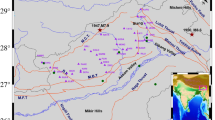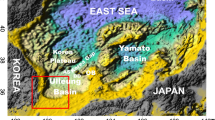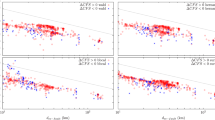Last year's Indonesian earthquake has increased seismic hazard in the region.
Abstract
Following the massive loss of life caused by the Sumatra–Andaman earthquake in Indonesia and its tsunami, the possibility of a triggered earthquake on the contiguous Sunda trench subduction zone is a real concern. We have calculated the distributions of co-seismic stress on this zone, as well as on the neighbouring, vertical strike–slip Sumatra fault, and find an increase in stress on both structures that significantly boosts the already considerable earthquake hazard posed by them. In particular, the increased potential for a large subduction-zone event in this region, with the concomitant risk of another tsunami, makes the need for a tsunami warning system in the Indian Ocean all the more urgent.
Similar content being viewed by others
Main
Inspection of the aftershock distribution and evidence from recent inversions reveal that the Sumatra–Andaman earthquake of 26 December 2004 ruptured almost 0.25 million square kilometres of the Indian plate/Burma microplate subduction zone (Fig. 1), generating a tsunami. The current death toll is in the region of 300,000.
Subduction-zone earthquakes are often coupled: in the Nankai trough subduction zone to the southeast of Japan, for example, five of the seven large earthquakes on the Nankaido segment in the past 1,500 or so years were accompanied by similar events on the contiguous Tonankai/Tokai segment within five years, and three of those occurred in the same year1. This observation is entirely consistent with stress interaction, which has been shown to explain the space–time juxtaposition of large earthquakes2. The destructive Izmit earthquake (magnitude 7.4) southeast of Istanbul, for example, was triggered by stress increases of less than 2 bars that were due to earlier local events3; in turn, this triggered the Düzce earthquake (magnitude 7.1), which occurred three months later4.
Previous work on the palaeoseismology of the Sunda trench has indicated that this area may already be advanced in the seismic cycle5. The northern section of the Sumatra fault has not experienced any large earthquakes for at least the past 100 years either.
Waveform-inversion studies reveal a strongly heterogeneous slip distribution for the Sumatra–Andaman earthquake, with maximum displacements being of the order of 20 m and the majority of the slip being concentrated on the southernmost 500 km or so of the rupture6. We used this slip distribution to calculate the stress perturbation tensor, which was then resolved on the structures of interest. Results show a stress increase of up to 5 bars in the 50 km of the Sunda trench next to the rupture zone, but they also show a strong positive loading of up to 9 bars for about 300 km on the Sumatra fault near the city of Banda Aceh (Fig. 2).
Calculated three-dimensional stresses have been projected on to a diagram of the three-dimensional structural geometry and geography of the region. Grey-scale values on the rupture plane represent the amount of slip in metres experienced on the southernmost 450 km of the Sumatra–Andaman earthquake. Colour-scale values represent the co-seismic stress changes on the Sunda-trench subduction zone and the Sumatra fault. Stress contours (in black) show 2-bar intervals, starting from a maximum of 8 bars on both faults. Essential features of the calculated stresses are robust to changes in the slip distribution in recent long-period inversions, which show continuation of slip to the north for a total rupture length of about 1,200 km (ref. 10). Black asterisk indicates location of the devastated Indonesian city of Banda Aceh.
The results indicate that although a subduction-zone event in the Sunda trench has been made more likely by the Sumatra–Andaman earthquake, at present the increase in stress is localized on the north of this segment. The effect might be expected to spread further south in the months ahead as a result of viscoelastic relaxation in the lower crust, which has not been calculated here7. Earthquakes on the Sunda trench in 1833 and 1861 are known to have produced fatal tsunamis8.
The co-seismic stress perturbation on the Sumatra fault described here is significantly larger and of a greater spatial extent than the stresses that are believed to have triggered large, strike–slip earthquakes in the North Anatolian Fault Zone2. Considering past activity and the observed structural complexity on the northern Sumatra fault9, an earthquake of magnitude 7–7.5 on this structure would seem to represent the greatest immediate threat.
References
Rydelek, P. A. & Sacks, I. S. Earth Planet. Sci. Lett. 206, 289–296 (2003).
Stein, R. S., Barka, A. A. & Dieterich, J. H. Geophys. J. Int. 128, 594–604 (1997).
Nalbant, S. S., Hubert, A. & King, G. C. P. J. Geophys. Res. 103, 24469–24486 (1998).
Hubert-Ferrari, A. et al. Nature 404, 269–272 (2000).
Zachariasen, J., Sieh, K., Taylor, F. W., Edwards, R. L. & Hantoro, W. S. J. Geophys. Res. 104, 895–919 (1999).
Ji, C. http://neic.usgs.gov/neis/bulletin/neic_slav_ff.html (2005).
Pollitz, F. F. & Sacks, I. S. Bull. Seismol. Soc. Am. 87, 1–10 (1997).
Newcomb, K. R. & McCann, W. R. J. Geophys. Res. 92, 421–439 (1987).
Genrich, J. F. et al. J. Geophys. Res. 105, 28327–28341 (2000).
Stein, S. & Okal, E. Nature (in the press).
Author information
Authors and Affiliations
Corresponding author
Ethics declarations
Competing interests
The authors declare no competing financial interests.
Rights and permissions
About this article
Cite this article
McCloskey, J., Nalbant, S. & Steacy, S. Earthquake risk from co-seismic stress. Nature 434, 291 (2005). https://doi.org/10.1038/434291a
Published:
Issue Date:
DOI: https://doi.org/10.1038/434291a
This article is cited by
-
What Turkey’s earthquake tells us about the science of seismic forecasting
Nature (2023)
-
Stress accumulation and earthquake activity on the Great Sumatran Fault, Indonesia
Natural Hazards (2023)
-
Twenty-Five Years of Progress in the Science of “Geological” Tsunamis Following the 1992 Nicaragua and Flores Events
Pure and Applied Geophysics (2019)
-
Long-term seismic observations along Myanmar–Sunda subduction margin: insights for 2004 Mw > 9.0 earthquake
International Journal of Earth Sciences (2018)
-
Co-seismic offsets due to two earthquakes (M w 6.1) along the Sumatran fault system derived from GNSS measurements
Earth, Planets and Space (2016)
Comments
By submitting a comment you agree to abide by our Terms and Community Guidelines. If you find something abusive or that does not comply with our terms or guidelines please flag it as inappropriate.





